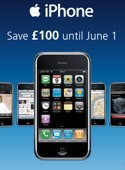Let’s get specific
It was sad to see the plugged pulled on Mowser, which was aimed at bringing the full web to mobile devices with less-capable browsers. I thought it was a great idea and well-executed, from someone who really gets mobile.
It did have problems to overcome though. For starters, many people don’t know that they can browse the full web (via Mowser or elsewhere) on their phone. And, if they do browse the web on their handheld, it’s probably using the amazing Opera Mini, which is an incredible (and low bandwidth) way to make the web usable on almost any phone.
But behind this is the gradual trend for mobile devices to sport very capable browsers. Symbian and the iPhone OS have great browsers built in, and can handle most web pages. So is there still a space for services that re-purpose content for mobile?
Learn to code the Mobile Web
Mobile trends and developments have been moving at very fast rate since the iPhone raised the bar, in terms of both the user experience and how the mobile device can be used in our busy everyday lives.
Back in the 90s, mobile development began with WAP sites consisting of a collection of “cards” making up a site. You were limited to wap images (*.wbmp) and very limited user client side interaction with the browser. See Wap Basics at W3C for more details.
Now, high profile sites that you can visit on browsers such as Symbian’s (Webkit-based) browser or iPhone’s Safari are based on current web standards used by desktop computers, and often written in XHTML (eXtensible Hyper Text Markup Language). However, we can now target for these handsets and for older phone models using the magic of CSS. The CSS file specifically targets mobile browsers, the CSS tells the browser how the layout and presentation is ordered.

£100 off will drive a few sales, but why do it at all?
 For the third time since its release, the iPhone has had a massive price cut. Following the recent price drops in Germany, today saw O2 and Carphone Warehouse knock £100 off the price of an 8GB iPhone. Plus, if bought through cash-back merchant Quidco with an O2 contract, the price drops to just £69!
For the third time since its release, the iPhone has had a massive price cut. Following the recent price drops in Germany, today saw O2 and Carphone Warehouse knock £100 off the price of an 8GB iPhone. Plus, if bought through cash-back merchant Quidco with an O2 contract, the price drops to just £69!
Why is Apple’s unsubsidised uberphone suddenly so cheap?
Imitation is the sincerest form of flattery – but it’s not Elegant
You, me and next door’s cat know that a lot of the hardware and software designs coming from world phone manufacturers and mobile developers have been directly inspired by the Apple iPhone. All of a sudden full-screen interfaces are back in fashion, with even Windows Mobile getting finger-friendly additions bolted on wherever possible. From HTC’s TouchFLO to third party utilities, the finger-lovin’ starts off as reasonably impressive and then disappoints fairly soon afterwards. And there are a whole crop of proprietary OS devices with iPhone pretensions, such as the LG Viewty, about as close to the iPhone as you can get while still being able to say ‘hey, don’t send the lawyers round here, guv, this is totally different’. (more…)
The Carnival and the Boom!
Round here, we’re a big fans of Booms! They’re often found in Steve Jobs’ keynote presentations, heralding new things that you never knew you needed before, but have to get right now.
This week’s Carnival at mobilejones also focusses on the Boom! – this time in mobile data and the always-on lifestyle. As well as once again featuring yours truly*, it’s a good read, and there are a couple of complementary posts about mobile data usage.
(1) Chetan Sharma looks at the numbers, showing mobile data is taking off in the US
http://www.chetansharma.com/blog/2008/04/11/mobile-data-the-state-of-the-union/
(2) C. Enrique Ortiz looks at the confluence of factors as to why this is happening
Basically, the networks are getting there and the handsets are getting there. As awareness of the possibilities of the connected lifestyle rises, so does (data) usage.
*It’s getting a bit self-referential round here, so I’ll step up the frequency of posts.
Introducing Jim
In case you hadn’t noticed, this is a blog about the iPhone, and one of the striking aspects of this device is the web browser. It is one of the most usable of any mobile platform, and in its short existence has forced web developers to re-think how they develop for the mobile web.
In this vein, I’d like to introduce All About iPhone’s newest writer, Jim Callender. Jim’s an award-winning web developer who’s going to give us insight from the other side of the coin – the developers who are responding to demand for websites that work just as well when mobile. Browsers such as Safari on the iPhone are a key part of this trend.
Jim’s just back from South by South West. Do read his wrap up of the conference if you get a chance. He has lots of fresh ideas, and I hope you’ll enjoy what he has to say.

There’s something else in the air
 Back in the day (ahem, 2003), I was amazed when I hooked up my Nokia N70 with an account at Mightyphone and was able to bi-directionally sync my contacts. Any changes made through their web interface appeared on the phone and vice-versa. This was my first smartphone, and it seemed like magic. Unfortunately (owing to Orange’s data charges) it was expensive magic, and consequently I had to drop the service because of cost. But in the following 5 years, data charges have dropped. Over-the-Air (OTA) synchronisation is now not only technically feasible but actually affordable.
Back in the day (ahem, 2003), I was amazed when I hooked up my Nokia N70 with an account at Mightyphone and was able to bi-directionally sync my contacts. Any changes made through their web interface appeared on the phone and vice-versa. This was my first smartphone, and it seemed like magic. Unfortunately (owing to Orange’s data charges) it was expensive magic, and consequently I had to drop the service because of cost. But in the following 5 years, data charges have dropped. Over-the-Air (OTA) synchronisation is now not only technically feasible but actually affordable.
(more…)
Carnival of the Mobilists #117
The latest Carnival is available over at mobilestance.com, and I’m honoured that Jamie has chosen my post on iPhone gaming as the Post of the Week.
Check out the Carnival at http://mobilestance.com/2008/03/31/carnival-of-the-mobilists-117-is-here/
I suppose I’d better hurry up and write some more 
